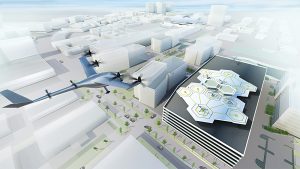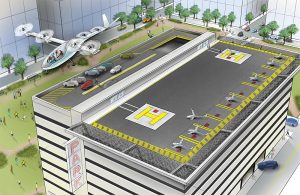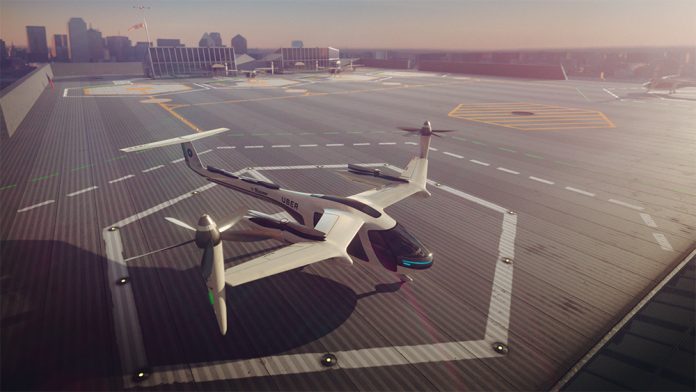Everyone has hopes and dreams for the future. Some are more immediate than others, like finding a close parking spot, and others are more grandiose, like putting a man on Mars. But, most of us who anxiously tap our steering wheels during rush-hour traffic can admit to occasional fleeting fantasies of flying cars. How great it would be to break free from a pre-determined, two-dimensional path and soar over the backlog! Not in your lifetime, you say? The city of Frisco is happy to report that dream might be closer to reality than you think.
The story starts with seemingly divergent puzzle pieces. Ross Perot becomes interested in creating aviation capabilities for the commercial sector and builds the world’s first industrial airport, Alliance Airport. Mark Moore becomes a revered engineer at NASA, specializing in vertical take-off and landing (VTOL) technology. Ross Perot Jr. founds Hillwood and becomes a leader in commercial, industrial and residential real estate development with a strong presence in transportation and aviation projects, among others. Fort Worth-based Bell Helicopter becomes a leading provider of VTOL aircraft, such as the Bell Boeing V-22 Osprey. Kerrville-based Mooney International hones its specialization in small private aircraft manufacturing. Slovenia-based Pipistrel Aircraft develops fully-electric aircraft and flies them for more than 15 years. Sao Paulo-based Embraer, a commercial aircraft manufacturer, becomes a leader in automated flight control systems. Frisco puts itself on the national map with its innovation in planning, creative partnerships and continuous pursuit of success. Uber shakes up the paradigm of daily travel with its innovative take on ride-sharing.
How do these lifelines connect? They all sit at the table of an air taxi concept initiated by Uber Elevate. In an in-depth white paper on their website, uberelevate.com, the analysis of daily air travel is impressive in its detail, exploration of barriers and its aggressive pursuit of making what we might call “flying cars” a reality.
 All players at the table are working different angles of the complex endeavor to bring 100 percent electric VTOL aircraft to fruition. This is no pie-in-the-sky dream anymore. Bell has already revealed its four-passenger concept model at the 2018 Consumer Electronics Show. With the increased interest in electric cars, battery life span is increasing while its size and weight are decreasing. Fortuitously, Hillwood’s land holdings have paved the way for the first VTOL route between DFW International Airport and Frisco. Frisco’s forward-thinking and collaborative nature has once again put the city’s name on the map, making it recognizable across the world. The only other location in the world that Uber Elevate has currently earmarked for near-future VTOL aircraft travel is Dubai, but Frisco will get the honor of being first.
All players at the table are working different angles of the complex endeavor to bring 100 percent electric VTOL aircraft to fruition. This is no pie-in-the-sky dream anymore. Bell has already revealed its four-passenger concept model at the 2018 Consumer Electronics Show. With the increased interest in electric cars, battery life span is increasing while its size and weight are decreasing. Fortuitously, Hillwood’s land holdings have paved the way for the first VTOL route between DFW International Airport and Frisco. Frisco’s forward-thinking and collaborative nature has once again put the city’s name on the map, making it recognizable across the world. The only other location in the world that Uber Elevate has currently earmarked for near-future VTOL aircraft travel is Dubai, but Frisco will get the honor of being first.
On a broader scale, Russell Laughlin, the executive vice president of Hillwood, says, “There are a lot of reasons around the Dallas/Fort Worth area, if you think about it. It is centrally located, has a highly-sophisticated aviation community and it has an international airport. It has a large geographic boundary and metropolitan area, so there are great distances to travel. It has a fast-growing economy, as well as population and transportation challenges, and Uber has a successful existing business platform here.”
After Uber Elevate’s international symposium in Dallas last year, announcing its plan for 100 percent electric on-demand VTOL aircraft by 2023, the world took notice and mistakenly thought the first flight would take place in Dallas. “The entire region is often referred to as ‘Dallas,’” Mr. Laughlin says. “But it took people a year to realize it is not Dallas! The first flight on the North American continent is being flown between Frisco and DFW International Airport — not Dallas, not Fort Worth, but Frisco.”
So, how did Frisco get the honors? Hillwood is currently developing Frisco Station, a 240-acre mixed-used development next to The Star, that will provide a prime location for Uber Elevate’s first VertiPort. The plans for the VertiPort include space for housing and charging multiple VTOL aircraft and on-ground support services. The area in Frisco known as the $5 Billion Mile, as well as the hotbed of activity surrounding Texas State Highway 121 and the Dallas North Tollway intersection, will provide a high source of customers wishing to travel to DFW International Airport. And, it just so happens that one of the top existing Uber routes in North Texas today is between Frisco and the airport.
 In addition, Mr. Laughlin says, “Frisco, their leadership and their citizenry are highly-educated, very involved, very transparent and they are aggressive, in a positive way, in their pursuit of better alternatives for their community. For years, Frisco has been unabashed in saying they are going to be a world-class community. Those planning tenants, growth models and goals have attracted many of the residents who live here today.”
In addition, Mr. Laughlin says, “Frisco, their leadership and their citizenry are highly-educated, very involved, very transparent and they are aggressive, in a positive way, in their pursuit of better alternatives for their community. For years, Frisco has been unabashed in saying they are going to be a world-class community. Those planning tenants, growth models and goals have attracted many of the residents who live here today.”
Ron Patterson, the interim president of the Frisco Economic Development Corporation (EDC), adds that Frisco is focused on “overall master planning for transportation needs of the future … not just being constrained by what resources or technology are available today, but what is coming.”
Mr. Laughlin compares the Uber Elevate effort to the interstate highway system in the 1950s. “Although the interstate system was just highways, it was innovative in that it was interstate, coast-to-coast, border-to-border, and it connected our economy and provided efficiencies and a quality of life that drove America to be the world’s greatest industrial power. So, where is the next innovation? This sort of transportation (VTOL aircraft) is going to be one. It is three-dimensional and it exponentially gives you transportation options that you do not have today.”
The idea is tantalizing, but Mr. Laughlin acknowledges the initial doubt. “When people first hear of Uber Elevate, they think of George Jetson,” Mr. Laughlin says. “The knee-jerk reaction is that it does not sound like it is going to happen. But, when you look at the facts, what is happening in the industry, the leaders involved, what the Department of Defense is doing and what kids are doing with $900 drones today, the technology is there.”
He also recognizes a common reservation about VTOL aircraft. “The long-time public aversion to helicopters is real,” Mr. Laughlin points out. “It is the noise, for the most part — the loud chopping that goes on with these aircrafts. They are highly inefficient.”
Mr. Laughlin explains that a reduction in noise level, an increase in safety and an increase in efficiency can be gained by redundancies in batteries and electric motors. Noise feasibility tests are underway, as we speak, and once desired noise levels are determined, the design of the blades and other features can be adjusted to meet “a specific stratum and background noise in a metropolitan area.”
Based on load modeling and networks, Mr. Laughlin says Uber Elevate is targeting a four-passenger VTOL aircraft with initial space for a driver and plans to be fully-automated in later years. He also confirmed the current timeline of test flights beginning in 2020 and targeted commercial flight operations beginning in 2023. Given the expertise at the table, Mr. Patterson says it is a “dynamic team” bringing this to fruition.
“We would not be involved if we did not think this was a viable innovative transportation model,” says Mr. Laughlin. “It is exciting and we cannot wait until Uber Elevate starts flying its first test aircraft between DFW International Airport and Frisco Station in 2020.”
So, keep dreaming, rush-hour roadies! A 15-minute commute via air travel just might become a reality for you, too.


